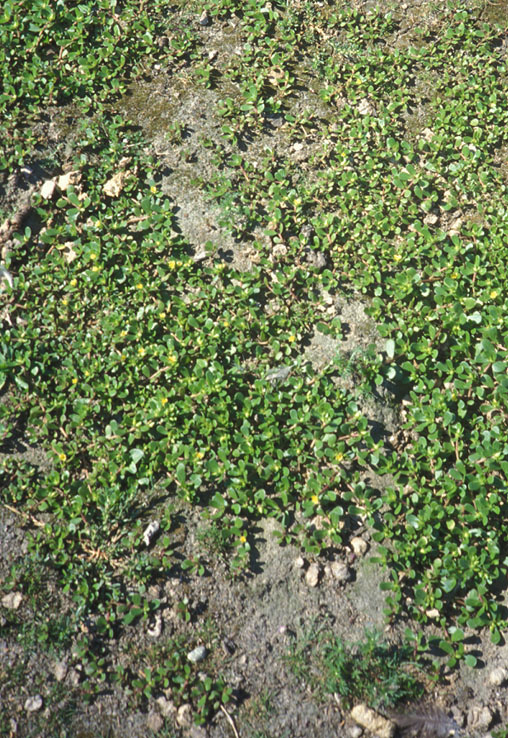
|
| Purslane; Portulaca oleracea L. |
Purslane Family; PORTULACACEÆ
|
| Purslane originated in the Old World. It is a low-growing summer-annual succulent herb. Seedlings sprout in late April or May.
Down into earth they drive taproots that can attain nearly 2 feet in length. From the center of the plant radiate spreading, sprawling,
branching stems, pinkish in color, thick, juicy, nearly rubbery. Along the stems are beset plump, flat leaves almost never more than
11/2 inches long, and tiny yellow flowers that open during sunny
mornings. Frost turns the plants to slimy mush. |
| Soil richness, available moisture, and level of sunlight determine whether a crop of this weed stays scrawny, dwarfish and
useless, or instead grows plump and rank so as to be a good wild vegetable. In any case, it is rarely a serious pest as far as harmfulness goes. In
fact, were it a perennial and less prolific, its good looks and adaptable groundcover habit might make it a worthy ornamental plant. Some of
its cousins are grown in rock gardens or flower borders, and wild relatives occasionally grown include Miner's Lettuce, Spring Beauty,
and Bitterroot (Montana's State Flower). |
| It grows best in rich, pampered, warm, sunny garden beds with other vegetables. It is not as readily found in sidewalk cracks, or
dusty paths in fields, nor does it do so well in such harsh sites. |
Gardeners must weigh the costs and benefits of Purslane. Few weeds are better eating. It possess pleasing flavor, mild and
vaguely sorrel-like; and a most unusual mucilaginous, crunchy, partly gritty texture that makes for an agreeable addition to salads. Many
people prefer to cook it. Improved, upright, larger garden strains are in cultivation. An ideal plan is to weed out the troublesome, runty
population, and preserve larger-growing specimens for regular harvesting of stem tips. Purslane is well-rounded nutritionally, not outstandingly
high in any particular nutrient (except Omega-3 fatty acids). Medicinal uses are absolutely trivial. Other names include Pussley, Pursley, and Duckweed.
|
Originally published as the Seattle Tilth newsletter Weed of the Month in September 1986, along with an illustration drawn by Jerri Geer.
Back |
|
|

